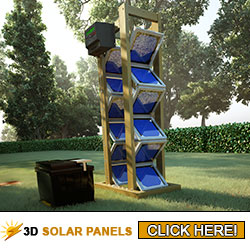Simply put, solar energy works by harnessing the energy of the sun and turning it into electricity.
Our Sun is an enormous nuclear reactor that sends free abundant energy to our planet. It is said that, in one hour, the Sun dispatches so much energy it would satisfy Earth’s yearly consumption needs!
This fact alone should be enough to get us all involved in solar energy and ditch fossil fuels for good… unfortunately, fossil fuels are still the biggest business and the sheer amount of money is what’s stopping the global recognition of renewable energy.
How Do Solar Panels Work and What Are They Made Of?
The main building block of a solar panel is a solar cell. These cells are made of silicon and are constructed to have a positive and negative layer. These layers serve to make an electric circuit, just like in a household battery.
Now, when a photon (photon is the basic unit of light) “hits” this solar cell, they knock the electrons loose. These “roaming” electrons are the basis of the entire solar power process as they flow through the circuit the positive and negative layers make.
How Many Solar Panels You Need?
The exact number of solar panels you’d need, depends on your goal:
- Do you want to save the most money and maximize your return on investment
- Do you want to minimize your carbon footprint
- Do you want to minimize your impact on the environment
For most people, the goal is a mix of saving money and helping the environment.
The Number Of Panels
To make this calculation as accurate as possible, you’ll need to grab your past utility bills… ideally, you’ll have an entire year’s worth of data.
What you then do is multiply your hourly energy consumption by the sunlight peak and divide by the panel’s wattage.
Once you get the math right and figure out the size of the solar panels you’d need, make sure to scope out your roof. You’d be surprised how many people miss this crucial step, go out and order solar panels only to find out their roof is much too small.
Hours Of Sunlight in Your Area
This is another crucial piece of information as you need to calculate the peak sunlight hours for your area. These peak hours will have a direct impact on how much energy you can expect.
Living in a “low peak area” does not mean you can’t use solar panels, it just means you’ll have to double down on the math and see how to make solar power work!
If you don’t want to do math and just “dip your feet”, you can try the Backyard Revolution program.





